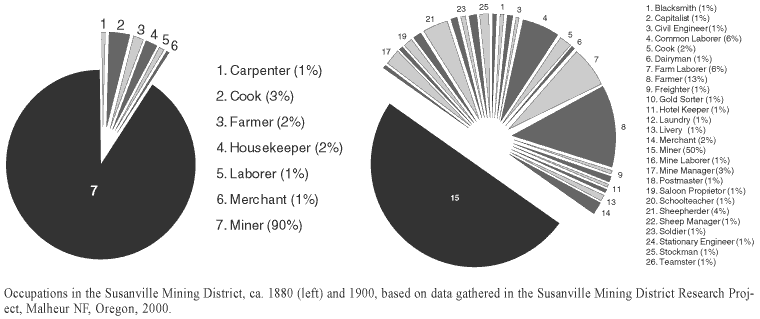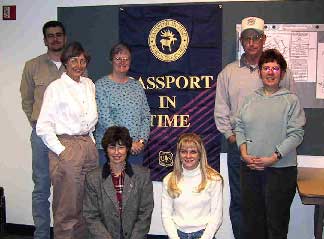Susanville Mining - Passport in Time
Main menu:
Previous Projects > States M-R
Susanville Mining District Research Project
Malheur National Forest, Oregon, 2000
by Don Rotell, FS Archaeologist
Did you know that there were 36 farms in the Susanville area in 1910? Or that Chinese made up 86 percent of the population of Susanville settlement in 1880? These are just a few aspects of life on the late-19th- and early-20th-century northeastern Oregon mining frontier that came to light during the Susanville Mining District Research PIT project. Six volunteers participated in the project, which was sponsored by the Blue Mountain Ranger District of the Malheur National Forest.
The objective of the project was to gather information from documentary sources and oral interviews that could be used to develop a mining context statement for the Middle Fork of the John Day River area. A historic context statement summarizes the history of a specific theme (i.e., mining, railroad logging, CCC) and is written at a local or regional scale. The document can then serve as a tool for cultural resource managers during identification and evaluation of historic properties related to the specific themes.
Context-driven management plans for large and complex cultural properties such as mining districts and cultural landscapes are critical if land-managing agencies are to preserve important historic imprints on the landscape in a cost-effective manner. Managing this type of resource on a landscape basis is key as the FS moves ahead with watershed restoration in the Blue Mountains Demonstration Area.
Sources of information that were consulted during the project include:
• 1870–1920 federal census schedules for the Elk Creek and Susanville precincts. The census schedules are excellent sources of information on the demography and social organization of well-established mining camps and settlements. Not unexpectedly, the census data show that Susanville began as a “bachelor society” of young males exploiting placer deposits of gold in the area, independently or in small groups. As the years passed by, occupations in the community become more diverse, and families characterized the composition of the population. We can also clearly see that Chinese immigrants formed a substantial portion of the Susanville population in the late 19th century. However, by the turn of the century, the Chinese population was in sharp decline, and almost no Chinese were present at the time of the 1920 census.

• 1920–1940s-era mineralogical reports on the Gem, Myrtle, and Princess hard rock mines in the Susanville district. These reports, filed with the state by mining engineers, describe the mineralogical and surface resources available on the claims. They also estimate the cost of ore haulage over roads and rail from the mines to smelters in Tacoma and San Francisco. Included in the reports are maps depicting claim improvements and underground workings; these maps will be useful for interpreting ore extraction and milling systems now present at the mines.
• 1880–1930 newspapers from Baker City, Sumpter, Long Creek, and Prairie City. Although mining town newspapers were often prone to embellishment, they can also supply extremely detailed accounts of activity in a mining district. Our volunteers transcribed over 80 articles from newspapers and constructed a time line of events for mining in the Middle Fork of the John Day River watersheds. The time line can be used to establish mining periods of significance for the historic context document.
• Local informants. Volunteers helped the Blue Mountain heritage team interview Cody and Marnie McConnell and Mildred McGirr in their homes. All of the informants had spent time in the Middle Fork of the John Day River area prior to World War II. They provided an additional perspective on the mines and the supporting communities of Susanville and Galena by sharing personal experience and recounting stories passed to them by parents and siblings.
This information is now available to any party engaged in studies of this era. We have the Susanville Historic Chronology (time line); the Gem, Princess, and Myrtle Mine mineralogical reports; transcripts of interviews with local informants; and the Susanville and Elk Creek precinct federal census records in Microsoft Word and Excel formats. If you are interested in using the data (or simply curious), contact the Blue Mountain heritage team, and we will e-mail you the records.
 Volunteers for the project included Judy Farnsworth of Boise; Ruth Ann Smith of Middleton, Idaho; Jim and Dottie Waddell of Oregon City; Joy Mentgen of La Grande; and Dennis Smith of Canyon City. They donated a total of 230 hours, working in libraries, museums, and at government offices in John Day and Baker City. Pat Lyttle of Portland obtained the census schedules and started the time line with research she conducted at the Oregon State Historical Society. We took breaks from microfilm viewing and data entry to tour the local Grant County Historical Museum and the Sumpter Valley Dredge State Heritage Area. Carolyn Micnhimer of the Kam Wah Chung Museum in John Day visited the project and gave a presentation on the history of Chinese immigrants in the mining towns and camps of northeastern Oregon.
Volunteers for the project included Judy Farnsworth of Boise; Ruth Ann Smith of Middleton, Idaho; Jim and Dottie Waddell of Oregon City; Joy Mentgen of La Grande; and Dennis Smith of Canyon City. They donated a total of 230 hours, working in libraries, museums, and at government offices in John Day and Baker City. Pat Lyttle of Portland obtained the census schedules and started the time line with research she conducted at the Oregon State Historical Society. We took breaks from microfilm viewing and data entry to tour the local Grant County Historical Museum and the Sumpter Valley Dredge State Heritage Area. Carolyn Micnhimer of the Kam Wah Chung Museum in John Day visited the project and gave a presentation on the history of Chinese immigrants in the mining towns and camps of northeastern Oregon.The project was a tremendous success. The information and history uncovered by the volunteers will improve the management of historic mining sites on the Malheur National Forest. Everyone had a lot of fun exploring the history of mining in the Blue Mountains and the community of Susanville. We celebrated the end of the project with an awards dinner at one of John Day’s finest eateries. Volunteers received a recently designed Blue Mountain Ranger District Heritage T-shirt and a book on FS history by Forest Archaeologist Don Hann.